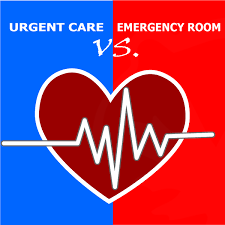- Sections :
- Crime & Public Safety
- Restaurants & Food
- Sports
- More
Priority ER explains the differences between emergency rooms and urgent care facilities

THE WOODLANDS, Texas — In our great State of Texas, emergency rooms and urgent cares are proliferating at a rapid rate. It’s rare while driving through urban and suburban areas, that you can drive 5 miles without seeing one or the other tucked away in a strip mall, adjacent to a hair salon, sushi restaurant or a Starbucks. You may not pay much attention until the time comes when you or a family member encounters an illness or injury and you need to seek out a doctor’s care. When an emergency strikes, where do you go? And what differentiates a freestanding emergency room (FSED) from an urgent care clinic (UCC)? There are differences in the scope of care of these facilities and it’s important for consumers to be informed of the differences, as well as laws and rights designed to protect YOU, the consumer and patient.
We often think of the emergency room as that which is physically attached to the hospital. We are almost culturally wired to automatically search for the nearest hospital in the event of a medical emergency. And with that automatic thought process, we’re also painfully aware of the wait times involved at a hospital emergency department. It’s not unusual for a patient to wait hours before being seen by a physician in a hospital ER. Thankfully, consumers now have more and better options to the traditional ER. Freestanding ERs, such as Priority ER, offer the same level of care as a traditional hospital emergency department, but without the wait and with more personalized care.
All freestanding ER’s are regulated by the State of Texas and as such, must adhere to strict guidelines. They must staff an ER physician, ER nurses and a radiology technologist at all times. They must remain open 24/7, and have advanced imaging such as computed tomography (CT Scan) and ultrasound, in addition to Xray. FSEDs can care for most emergent illnesses, including heart attack, stroke, or minor trauma and be able to administer all life saving procedures just like a hospital based ER. Also on site, there must be a lab capable of performing lab tests from a simple CBC (Complete Blood Count) to cardiac enzymes. When it comes to emergency medicine, time is a big factor, so having all the tools and docs with emergency medicine expertise on site is required.
ER’s must also have the word “emergency” on their signage. An urgent care may not use the word “Emergency” in their signage, so as not to confuse the public.
Priority ER is a member of Texas Association of Freestanding Emergency Centers. TAFEC helps to raise public awareness of the industry and promotes an overall understanding of the unique benefits of freestanding emergency centers.
An urgent care, on the other hand, runs more like a physician’s office, with extended hours. Patients may be seen by a nurse practitioner, a physician’s assistant or a doctor (most likely not an ER doctor). They may have limited radiology diagnostic tools such as X-ray and they can perform limited lab tests, such as flu, strep and urinalysis.
Urgent cares typically see patients with low to moderate acuity, such as minor infections, flu symptoms, allergies, sprains. Patients often seek urgent cares because they can walk-in without an appointment or after hours, when their primary care provider’s office is closed. At Priority ER, we have good working relationships with our local urgent cares, as people often don’t realize their condition requires more than an urgent care is capable of treating.
IN NETWORK? OUT OF NETWORK?
What about insurance networks? How does one know where to go? How do you determine if an ER is in network? Lawmakers and the American College of Emergency Physicicans (ACEP) understand the stresses associated with a sudden injuty or illness and have worked diligently to draft a law that is helpful to consumers.
In order to prevent a patient from wasting valuable time determining whether a facility is in network, the “Prudent Lay Person Provision” law was established to prevent insurance companies from unfairly charging out of network fees based on a diagnostic outcome. A 'prudent layperson' has been defined in the law as one who possesses an average knowledge of health and medicine, and the standard establishes the criteria that insurance coverage is based not on ultimate diagnosis, but on whether a prudent person might anticipate serious impairment to his or her health in an emergency situation.
'ACEP has long believed that anyone who seeks emergency care suffering from symptoms that appear to be an emergency, such as chest pain, should not be denied coverage if the final diagnosis does not turn out to be an emergency,' said Dr. Angela Gardner, ACEP President.
For example, before the “Prudent Layperson Law was passed, if a person was experiencing chest pain, visited an emergency room but it turned out to be a panic attack or indigestion, an insurance company may not have covered the claim at all. Today, the insurance company must pay the claim. The Prudent Lay Person Law is helpful for patients to know, especially when their bill comes due.
Equally important is for consumers to understand their particular policy and benefits. They are not all created equally and there are cost sharing components of each policy that consumers should familiarize themselves with. Here is a handy interactive guide to help consumers understand health plan networks.
DO FREESTANDING EMERGENCY ROOMS COST MORE?
Freestanding ERs, like Priority ER, do not cost more than a hospital based in ER, but to be clear, they are an emergency room. In order to treat life threatening emermgencies, all ERs have to have not only experienced physicians and nurses, but also the equipment and radiologists available 24/7 to quickly diagnose or treat an illness or injury.
Long gone are the days of excruciating wait times in hospital ERs. Consumerd in Texas, and increasingly nationally, have a lot of options when it comes to seeking immediate medical care. It is important to understand the differences in scope of services between health care facilities. As the consumer becomes more aware of the differences and the convenience of freestanding ER services, the trend will likely continue in other states.











